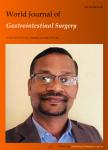Trends with neoadjuvant radiotherapy and clinical staging for those with rectal malignancies
Trends with neoadjuvant radiotherapy and clinical staging for those with rectal malignancies作者机构:Department of Surgical OncologyFox Chase Cancer Center Department of BiostatisticsFox Chase Cancer Center
出 版 物:《World Journal of Gastrointestinal Surgery》 (世界胃肠外科杂志(英文版)(电子版))
年 卷 期:2017年第9卷第4期
页 面:97-102页
核心收录:
学科分类:1002[医学-临床医学] 100214[医学-肿瘤学] 10[医学]
基 金:NCI NIH HHS [P30 CA006927] Funding Source: Medline
主 题:Neoadjuvant 治疗 社区 直肠的癌症 学术
摘 要:AIM To see how patterns of care changed over time,and how institution type effected these *** A retrospective analysis was performed using the National Cancer Database,looking at all patients that were diagnosed with rectal cancer from 1998 to 2011. We tested differences in rates of treatment and stage migration using χ~2 tests and logistic regression models. RESULTS A review of ninety thousand five hundred and ninety four subjects underwent multimodality therapy for cancer of the rectum. Staging and response to treatment varied greatly between centers. Forty-six percent of the time staging was missing in academic practices,vs fiftyfour percent of the time in community centers(P 0.001). As a result,twenty-percent were down-staged and eight percent up-staged in academia,whereas only fifteen percent were down-staged and 8% up-staged in community practices(P 0.001). Forty-two percent of individuals underwent radiation before surgery in *** two years this increased to fifty-three percent. This increased to eighty-six percent by 2011(P 0.001). Institution specific treatment varied greatly. Fifty-one percent received therapy before surgery in academic centers in 1998. Thirty-nine percent followed this pattern in the same year in the community(P 0.001). By 2011,ninety-one percent received radiation before their procedure in academic centers,vs eighty-four percent in the community(P 0.001). Rates of adoption were better in academia,although an increase was seen in both center types. CONCLUSION From the study dates of 1998 to 2011,preoperative treatment with radiation has been on the rise. There is certainly an increased rate of use of radiation in academia,however,this trend is also seen in the community. Practice patterns have evolved over time,although rates of assigning clinical stage are grossly underreported prior to initiation of preoperative therapy.



